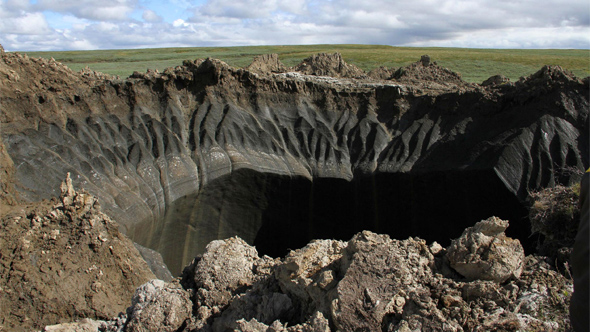
Climate change is already here, although the effects are unevenly distributed. Last winter saw a series of storms of record-breaking wind speeds, rainfall, and intensity hit the UK. California’s current drought has seen lakes disappear into parched earth. Giant craters have begun appearing in Siberia, as methane explodes out of thawing permafrost. This year Australia has seen wildfires the size of cities, clearly visible from space. The theoretical possibility of the glaciers of West Antarctica crossing tipping points into irreversible decline is now an observed scientific fact.
According to author Christian Parenti, climate change is contributing to conflicts in Kenya, Uganda, Latin America, central and south Asia. Furthermore, many analysts believe a severe drought was among the major contributing factors of the revolt-turned-civil war in Syria. The Pentagon has begun planning for catastrophic climate wars and social collapse, dovetailing the global counter-insurgency war machine constructed under the ‘War on Terror’ with the prospect of worldwide social unrest to come.
It is the outstanding achievement of capitalism to have exponentially increased production while maintaining poverty amidst plenty. Scarcity is maintained even amidst abundance. Tens of thousands of impoverished residents of Detroit have recently experienced this, as water supplies are cut. Detroit sits on the Great Lakes and has no shortage of fresh water. If the richest, most powerful nation in history forces its poor to go without essential services even amidst abundance, what grim prospects underscore climate-induced scarcity?
Climatic disasters are proliferating at an accelerating rate. The capitalist response is already clear: imposition of scarcity on the poorest. Insulation of the rich. A militarised policing of the class lines, themselves always racialised, wherever they threaten to spill over into social unrest. The Gaza Strip serves as a monstrous illustration of the militarised humanitarian management of surplus populations at a threshold just above genocide. The ideology of reactionary ecology is also well-honed: expect talk of overpopulation, natural famine, and anti-immigrant ‘lifeboat ethics’ to grow in step with the climate catastrophes.
But disasters also bring to the fore the latent social forces of mutual aid and self-organisation. Extraordinary crises give rise to extraordinary communities. In the San Francisco earthquake of 1906, it was the beleaguered citizens who organised relief while the state sent in the National Guard to suppress what it saw as disorder. A similar repressive state reaction followed Hurricane Katrina. But even when the state doesn’t send in the troops, it still can’t compete with the effectiveness of self-organised mutual aid.
The Department of Homeland Security even praised the efforts of Occupy Sandy in organising disaster relief. Occupy Sandy was only a more media-savvy and overtly anarchist form of the kind of spontaneous anarchism found among disaster survivors everywhere. The psychologist Charles Fritz, after studying a number of disasters, set out to dispel the common myth of a descent into ‘every man for himself’:
“Even under the worst disaster conditions, people maintain or quickly regain self-control and become concerned about the welfare of others (…) much more is given away than stolen. Other forms of antisocial behaviour, such as aggression toward others and scapegoating, are rare or non-existent.”
Disasters, while producing undeniable misery, also bring to the fore the latent power of reciprocity, which always remains submerged, fractured, and inchoate in the capitalist world of exchange. In this way, the kind of improvised, spontaneous mutual aid which characterises disaster communities points to latent potentials for radical social change. Fritz, again:
“People see the opportunity for realising certain wishes that remained latent and unfulfilled under the old system. They see new roles that they can create for themselves. They see the possibility of wiping out old inequities and injustices.”
The immediacy of climate change is producing a multitude of distributed disasters, not to mention localised struggles against fossil-fuel capital. What links indigenous pipeline resistance in North America to fracking protestors in Balcombe to anti-pollution riots in China is capitalist development itself. As capitalism attempts to open new areas for exploitation, it generates new connections. If these can be weaponised into relations of solidarity and reciprocity, the beginnings of a movement adequate to meet the disaster of capitalist climate change may start to take shape.
The needs-based reciprocity of disaster communities and the militant solidarity of those who put their bodies on the line to block the further development of fossil capital point to an anti-capitalist movement against climate catastrophe. Capitalism is in no more of a hurry to mitigate and adapt to climate change than it is to end world hunger. But the technological possibilities exceed what counts as economically rational under capitalist criteria.
From the point of view of the market, there’s no point producing for the needs of those who can’t pay. But disaster communities show an alternative logic can prevail even in the most appalling circumstances. A decision to leave fossil fuels in the ground is an ecological necessity but an economic stupidity, under capitalist reasoning. Yet the technology for a rapid shift to renewable energy already exists. Desalination plants can provide potable water as rising sea levels salinate coastal aquifiers, something which is already happening in Mediterranean towns like Beirut. But capitalism already cuts off the water for the poor, and desalinated water would be dearer, and unlikely to be profitable.
The urgent challenges of climate change suggest we stand at a fork in the road between two diverging developmental paths. Social unrest seems inevitable. The only question is whether the demands for bread and freedom which shook North Africa and the Middle East can generate the force to break the hold of capitalist development. Will the 21st century see such movements fading quietly into the dystopia of capitalist climate change? Or the blossoming of a real utopia of self-organisation, reciprocity, and ecological production for human needs? State and capital stand together in the first camp. The second is the prize for those who would liberate the Earth from such monsters
By Out of the Woods | @out_woods | libcom.org/outofthewoods









